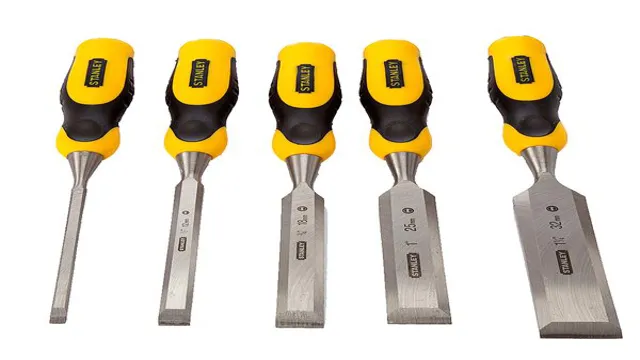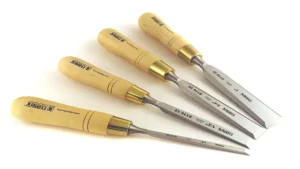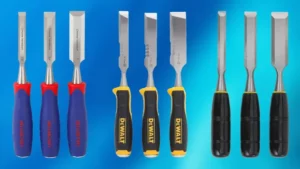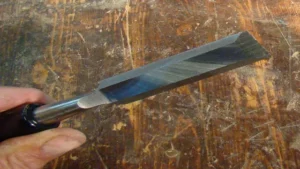Chisels are essential tools for any woodworker. Whether you are a professional craftsman or an enthusiastic apprentice, knowing how to choose the right size chisels is crucial for achieving remarkable results. Especially when it comes to intricate projects, chisels play a vital role in carving and shaping wood.
However, selecting the perfect size chisels can be a challenging task since various factors influence the decision. How deep do you want to carve? What is the thickness of the wood you are working with? Do you prefer larger or smaller chisels? With all these questions in mind, it is vital to take the time to evaluate which chisels will provide the most efficient results. In this blog post, we will explore how to choose the perfect size chisels to help you create beautiful woodwork pieces with ease.
Understanding Chisel Sizes
If you’re a woodworker or a carpenter, you might be wondering about what size chisels you should buy. Chisels come in a variety of sizes, and having the right one for the job can make all the difference. The most common sizes for chisels are 1/4 inch, 1/2 inch, and 3/4 inch.
These are good sizes to start with if you’re just beginning your chisel collection. The size of the chisel you choose will depend on the size of the work you’re doing. For example, if you’re working on smaller pieces, such as carving detailed designs, you’ll want a smaller chisel.
Alternatively, if you’re working on larger pieces, such as removing a lot of wood from a project, you’ll want a larger chisel to get the job done more quickly. It’s important to remember that chisels need to be sharp in order to work effectively, so investing in a good sharpening system is a good idea. Overall, the size of the chisel you choose will depend on your specific needs and the size of the project you’re working on.
Blade Width vs. Overall Length
Chisel sizes can be confusing for those who are not familiar with them, especially when it comes to understanding blade width vs. overall length. Overall length refers to the entire length of the chisel, while blade width refers to the width of the actual cutting edge of the chisel.
It’s important to consider both when selecting a chisel, as different tasks may require different blade widths and overall lengths. For example, a wider blade width might be better for heavy-duty tasks, while a shorter overall length might be more maneuverable in tight spaces. Additionally, it’s important to consider the handle material and grip, as well as the steel quality of the blade.
With all these factors in mind, it’s easy to see why choosing the right chisel can make a big difference in the quality and ease of your work.

Matching Chisel Size to Project
When it comes to woodworking, one of the essential tools to have is a chisel. However, with so many different sizes available, it can be challenging to determine which one is best for a particular project. Understanding chisel sizes is vital, as using the wrong size can result in a poor outcome.
Chisels come in different sizes, ranging from 1/8 inch to 2 inches in width. The size of the chisel you choose should depend on the task at hand. For instance, a smaller chisel (1/8 inch or 1/4 inch) is ideal for intricate work, while a larger chisel (1 inch or 2 inches) is better used for heavy-duty work.
When considering chisel size, it’s also important to think about the type of wood you’re working with. For softwoods, such as pine or spruce, a smaller chisel works best, while hardwoods, such as oak or hickory, require a larger chisel. In conclusion, understanding chisel sizes is crucial when undertaking woodworking projects.
By choosing the right size, you can achieve the desired outcome. When in doubt, it’s always better to err on the side of caution and use a smaller chisel, as it’s easier to adjust to a bigger size than the other way around.
Factors to Consider when Buying Chisels
When it comes to buying chisels, there are a few important factors to consider to ensure you get the right ones for your needs. One of the most common questions people have is what size chisels they should buy. The answer really depends on what type of work you’ll be doing.
If you’re primarily doing fine detail work, you’ll likely want to opt for smaller chisels, such as ¼ inch or ½ inch. For more general woodworking tasks, you might want to consider 1 inch or 1 ½ inch chisels. It’s also important to consider the material the chisels are made from, as this can impact their durability and ability to hold an edge.
High-quality steel is typically the best choice, as it can withstand heavy use and maintain its sharpness over time. Finally, don’t forget to consider the handle, as this can impact your comfort and control while using the chisels. Look for handles that fit comfortably in your hand and allow you to apply the necessary force without causing strain or discomfort.
With these factors in mind, you’ll be able to choose the right chisels to meet your needs and achieve great results in your woodworking projects.
Quality of Steel
Chisels are an indispensable tool for any carpenter or DIY enthusiast. The quality of the steel used to make a chisel is one of the critical factors to consider when purchasing one. The quality of the steel determines the durability, sharpness, and strength of the chisel.
High-quality steel will make a chisel more durable and resistant to wear and tear. A good chisel should have a high carbon content that makes it hard and durable. However, it is essential to be cautious not to buy chisels with too much carbon content as they can become brittle and break easily.
The quality of steel is also related to the price of the chisel. Cheap chisels may seem like a good deal, but they are made from lower-grade steel and will not last as long or perform as well as a more expensive, high-quality chisel. Therefore, it is essential to invest in a high-quality chisel that has the right balance of carbon content at a reasonable price to ensure that your chisel serves you well for many years to come.
Handle Comfort and Grip
When looking for chisels, it’s essential to consider handle comfort and grip. You want a tool that feels good in your hand, so you can work for extended periods without becoming fatigued. A non-slip grip is also a must, as it ensures that you have control over the tool.
When shopping for chisels, take the time to hold a few and feel which ones fit your hand best. Look for chisels with ergonomic handles that reduce strain on your hands and wrists. Additionally, the material of the handle can also impact grip and comfort.
For example, a rubberized handle can provide a better grip than a smooth wooden one. Consider these factors when looking for chisels to ensure that you have a comfortable and secure tool to work with.
Budget Constraints
When it comes to buying chisels, budget constraints can be a major factor. Not all chisels are created equal, and the cost can vary greatly depending on the quality and type of the tool. For those on a tight budget, it’s important to prioritize which chisels are necessary for the project at hand.
For example, a beginner woodworker may only need a few basic chisels to get started, while a more experienced craftsman may require a wider range of specialty chisels. It’s also important to consider the durability of the chisels and whether they will need to be replaced frequently. Investing in higher quality chisels may cost more upfront, but can ultimately save money in the long run.
Overall, it’s important to determine what your specific needs are and what budget you have to work with when choosing the right set of chisels.
Recommended Chisel Sizes for Common Projects
If you’re new to woodworking, one of the first questions you may ask is, “What size chisels should I buy?” The answer ultimately depends on the projects you plan on undertaking. For finer, detailed work such as trimming and fitting joints, a set of smaller chisels ranging from ¼ inch to 1 inch may be best. On the other hand, for larger projects such as timber framing or rough carpentry, a set of larger chisels ranging from 1 inch to 2 inches may be more appropriate.
Of course, having a variety of sizes in your toolkit is always helpful, but starting with the sizes that are most relevant to your planned projects is a good starting point. Remember, quality also matters. Investing in well-made chisels will save you frustration and provide better results.
So, regardless of size, make sure to select chisels that are sharp, sturdy, and comfortable to use.
Chisel Size Chart for Woodworking
Woodworking chisels are a vital tool for any woodworker. However, with the numerous sizes and styles available, it can be challenging to select the right one for your project. To achieve the best results, it’s essential to use a chisel that accurately matches the width of the part you need to trim or shape.
A recommended chisel size for mortising is ¼ inch-½ inch, while a ¾ inch-1 inch chisel is ideal for chopping wood. For carving intricate designs, consider using a ⅛ inch-¼ inch chisel. Smaller widths are suitable for detailed work, while wider widths are ideal for larger projects.
Furthermore, you’ll need to ensure the sharpness of the chisel as a dull chisel can cause injury or a ruined final product. With the understanding of recommended chisel sizes for common projects, selecting the perfect size for your project will be an easy task.
Chisel Size Chart for Metalworking
When it comes to metalworking, chisels are an essential tool for shaping, cutting, and carving metal. But with so many different chisel sizes available, it can be difficult to know which one to use for different projects. That’s why we’ve created this chisel size chart to help you choose the right chisel for your needs.
For finer and more detailed work, a smaller chisel size such as 1/8″ or 1/4″ may be best. However, for larger and more heavy-duty projects, a larger chisel size of 1/2″ or 3/4″ may be necessary. It’s important to choose the right size for your project in order to achieve the best results.
With this chisel size chart, you’ll be able to find the perfect chisel size for any metalworking project.
Conclusion
At the end of the day, the size chisels you should buy is entirely dependent on the scope of your woodworking projects and personal preference. Are you working on detailed, intricate pieces? Opt for a set of small, precise chisels. Or, are you more interested in larger, rougher projects? Larger chisels may be the way to go.
Whatever your preference, invest in a high-quality set that meets your needs and start chiseling away!”
FAQs
1. What types of chisels are available for woodworking? – Answer: Some common types of chisels for woodworking include bench chisels, butt chisels, mortise chisels, fishtail chisels, and skew chisels. 2. What sizes of chisels are recommended for beginners? – Answer: Beginners should consider starting with a set of three chisels, including 1/2 inch, 3/4 inch, and 1 inch sizes. 3. What are the benefits of purchasing high-quality chisels? – Answer: High-quality chisels can provide better control, increased durability, and consistent performance, making them a worthwhile investment for serious woodworkers. 4. Should I choose a beveled or firmer chisel for my woodworking projects? – Answer: Beveled chisels are more versatile and can handle a wider range of tasks, while firmer chisels are stronger and better suited for heavy-duty work, such as timber framing. 5. What is the proper way to sharpen and maintain my chisels? – Answer: Regular maintenance and sharpening can help prolong the life and performance of your chisels. This involves honing the edge, flattening the back, and storing them in a dry place. 6. Can I use chisels for tasks other than woodworking? – Answer: While chisels are primarily designed for woodworking, they can also be used for metalworking, carving, and even DIY projects around the house. 7. What safety measures should I take when using chisels? – Answer: Always wear eye protection and gloves, and make sure your workpiece is securely clamped down. Additionally, be mindful of where your hands are in relation to the blade and always cut away from your body.





